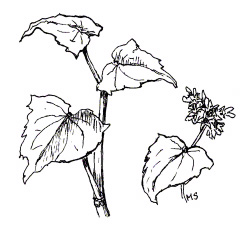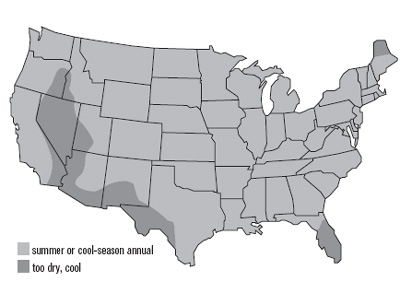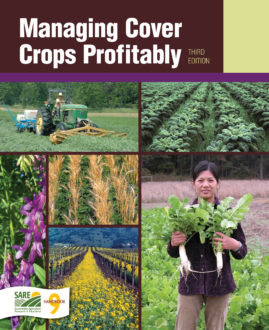
Buckwheat (Fagopyrum esculentum)
Type: summer or cool-season annual broadleaf grain
Roles: quick soil cover, weed suppressor, nectar for pollinators and beneficial insects, topsoil loosener, rejuvenator for low-fertility soils
Mix with: sorghum-sudangrass hybrids, sunn hemp
See charts, pp. 66 to 72, for ranking and management summary.
Buckwheat is the speedy short-season cover crop. It establishes, blooms and reaches maturity in just 70 to 90 days and its residue breaks down quickly. Buckwheat cover crops suppress weeds and attract beneficial insects and pollinators with its abundant blossoms. It is easy to kill, and reportedly extracts soil phosphorus from soil better than most grain-type cover crops.
Buckwheat thrives in cool, moist conditions but it is not frost tolerant. Even in the South, it is not grown as a winter annual. Buckwheat is not particularly drought tolerant, and readily wilts under hot, dry conditions. Its short growing season may allow it to avoid droughts, however.
Benefits of Buckwheat Cover Crops
Quick cover. Few cover crops establish as rapidly and as easily as buckwheat. Its rounded pyramid- shaped seeds germinate in just three to five days. Leaves up to 3 inches wide can develop within two weeks to create a relatively dense, soil shading canopy. Buckwheat typically produces only 2 to 3 tons of dry matter per acre, but it does so quickly—in just six to eight weeks (257). Buckwheat residue also decomposes quickly, releasing nutrients to the next crop.
Weed suppressor. Buckwheat’s strong weed suppressing ability makes it ideal for smothering warm-season annual weeds. It’s also planted after intensive, weed-weakening tillage to crowd out perennials. A mix of tillage and successive dense seedings of buckwheat can effectively suppress Canada thistle, sowthistle, creeping jenny, leafy spurge, Russian knapweed and perennial peppergrass (257). While living buckwheat may have an allelopathic weed-suppressing effect (351), its primary impact on weeds is through shading and competition.
Phosphorus scavenger. Buckwheat takes up phosphorus and some minor nutrients (possibly including calcium) that are otherwise unavailable to crops, then releasing these nutrients to later crops as the residue breaks down. The roots of the plants produce mild acids that release nutrients from the soil. These acids also activate slow-releasing organic fertilizers, such as rock phosphate. Buckwheat’s dense, fibrous roots cluster in the top 10 inches of soil, providing an extensive root surface area for nutrient uptake.
Thrives in poor soils. Buckwheat performs better than cereal grains on low-fertility soils and soils with high levels of decaying organic matter. That’s why it was often the first crop planted on cleared land during the settlement of woodland areas and is still a good first crop for rejuvenating over-farmed soils. However, buckwheat does not do well in compacted, droughty or excessively wet soils.
Quick regrowth. Buckwheat will regrow after mowing if cut before it reaches 25 percent bloom. It also can be lightly tilled after the midpoint of its long flowering period to reseed a second crop. Some growers bring new land into production by raising three successive buckwheat crops this way.

Soil conditioner. Buckwheat’s abundant, fine roots leave topsoil loose and friable after only minimal tillage, making it a great mid-summer soil conditioner preceding fall crops in temperate areas.
Nectar source. Buckwheat’s shallow white blossoms attract beneficial insects that attack or parasitize aphids, mites and other pests. These beneficials include hover flies (Syrphidae), predatory wasps, minute pirate bugs, insidious flower bugs, tachinid flies and lady beetles. Flowering may start within three weeks of planting and continue for up to 10 weeks.
Nurse crop. Due to its quick, aggressive start, buckwheat is rarely used as a nurse crop, although it can be used anytime you want quick cover. It is sometimes used to protect late-fall plantings of slow-starting, winter-hardy legumes wherever freezing temperatures are sure to kill the buckwheat.
Management of Buckwheat Cover Crops
Buckwheat prefers light to medium, well-drained soils—sandy loams, loams, and silt loams. It performs poorly on heavy, wet soils or soils with high levels of limestone. Buckwheat grows best in cool, moist conditions, but is not frost-tolerant. It is also not drought tolerant. Extreme afternoon heat will cause wilting, but plants bounce back overnight.
Establishment of Buckwheat Cover Crops
Plant buckwheat after all danger of frost. In untilled, minimally tilled or clean-tilled soils, drill 50 to 60 lb./A at 1/2 to 11/2 inches deep in 6 to 8 inch rows. Use heavier rates for quicker canopy development. For a fast smother crop, broadcast up to 96 lb./A (2 bu./A) onto a firm seedbed and incorporate with a harrow, tine weeder, disk or field cultivator. Overall vigor is usually better in drilled seedings. As a nurse-crop for slow growing, winter annual legumes planted in late summer or fall, seed at one-quarter to one-third of the normal rate.
Buckwheat compensates for lower seeding rates by developing more branches per plant and more seeds per blossom. However, skimping too much on seed makes stands more vulnerable to early weed competition until the canopy fills in. Using cleaned, bin-run or even birdseed-grade seed can lower establishment costs, but increases the risk of weeds. As denser stands mature, stalks become spindly and are more likely to lodge from wind or heavy rain.
Rotations for Buckwheat Cover Crops
Buckwheat is used most commonly as a mid-summer cover crop to suppress weeds and replace bare fallow. In the Northeast and Midwest, it is often planted after harvest of early vegetable crops, then followed by a fall vegetable, winter grain, or cool-season cover crop. Planted later, winterkilled residue provides decent soil cover and is easy to no-till into. In many areas, it can be planted following harvest of winter wheat or canola.
In parts of California, buckwheat grows and flowers between the killing of winter annual legume cover crops in spring and their re-establishment in fall. Some California vineyard managers seed 3-foot strips of buckwheat in row middles, alternating it and another summer cover crop, such as sorghum-sudangrass.
Buckwheat is sensitive to herbicide residues from previous crops, especially in no-till seedbeds. Residue from trifluralin and from triazine and sulfonylurea herbicides have damaged or killed buckwheat seedlings (79). When in doubt, sow and water a small test plot of the fast germinating seed to detect stunting or mortality.
Pest Management for Buckwheat Cover Crops
Few pests or diseases bother buckwheat. Its most serious weed competitors are often small grains from preceding crops, which only add to the cover crop biomass. Other grass weeds can be a problem, especially in thin stands. Weeds also can increase after seed set and leaf drop. Diseases include a leaf spot caused by the fungus Ramularia and Rhizoctonia root rot.
Other Options for Buckwheat Cover Crops
Plant buckwheat as an emergency cover crop to protect soil and suppress weeds when your main crop fails or cannot be planted in time due to unfavorable conditions.
To assure its role as habitat for beneficial insects, allow buckwheat to flower for at least 20 days—the time needed for minute pirate bugs to produce another generation.
Buckwheat can be double cropped for grain after harvesting early crops if planted by mid-July in northern states or by early August in the South. It requires a two-month period of relatively cool, moist conditions to prevent blasting of the blossoms. There is modest demand for organic and specially raised food-grade buckwheat in domestic and overseas markets. Exporters usually specify variety, so investigate before planting buckwheat for grain.
Management Cautions for Buckwheat Cover Crops
Buckwheat can become a weed. Kill within 7 to 10 days after flowering begins, before the first seeds begin to harden and turn brown. Earliest maturing seed can shatter before plants finish blooming. Some seed may overwinter in milder regions.
Buckwheat can harbor insect pests including Lygus bugs, tarnished plant bugs and Pratylynchus penetrans root lesion nematodes (256).
Comparative Notes
- Buckwheat has only about half the root mass as a percent of total biomass as small grains (355). Its succulent stems break down quickly, leaving soils loose and vulnerable to erosion, particularly after tillage. Plant a soil-holding crop as soon as possible.
- Buckwheat is nearly three times as effective as barley in extracting phosphorus, and more than 10 times more effective than rye—the poorest P scavenger of the cereal grains (355).
- As a cash crop, buckwheat uses only half as much soil moisture as soybeans (299).
